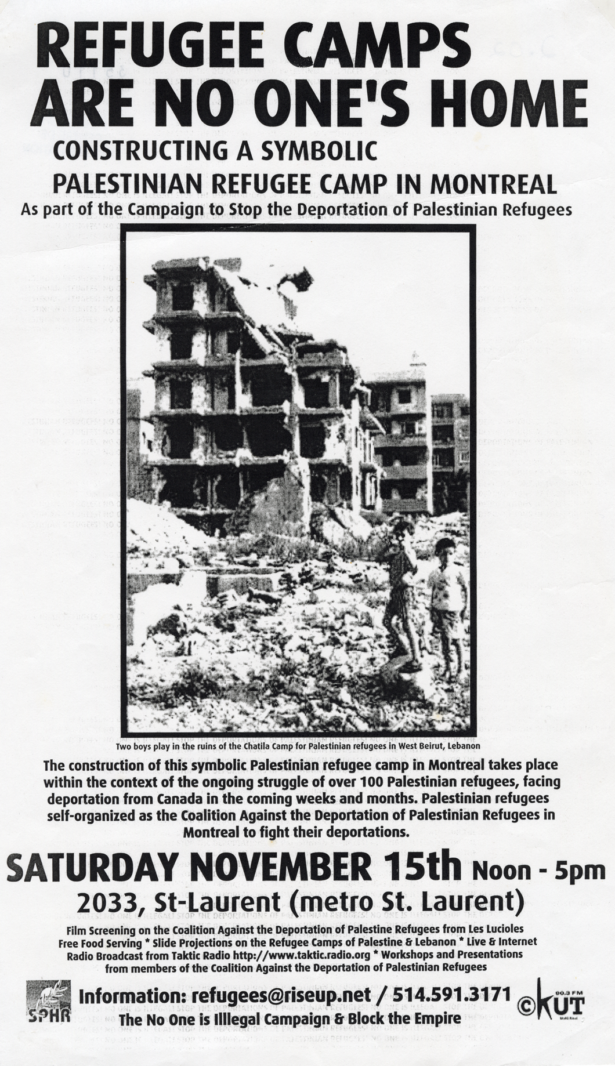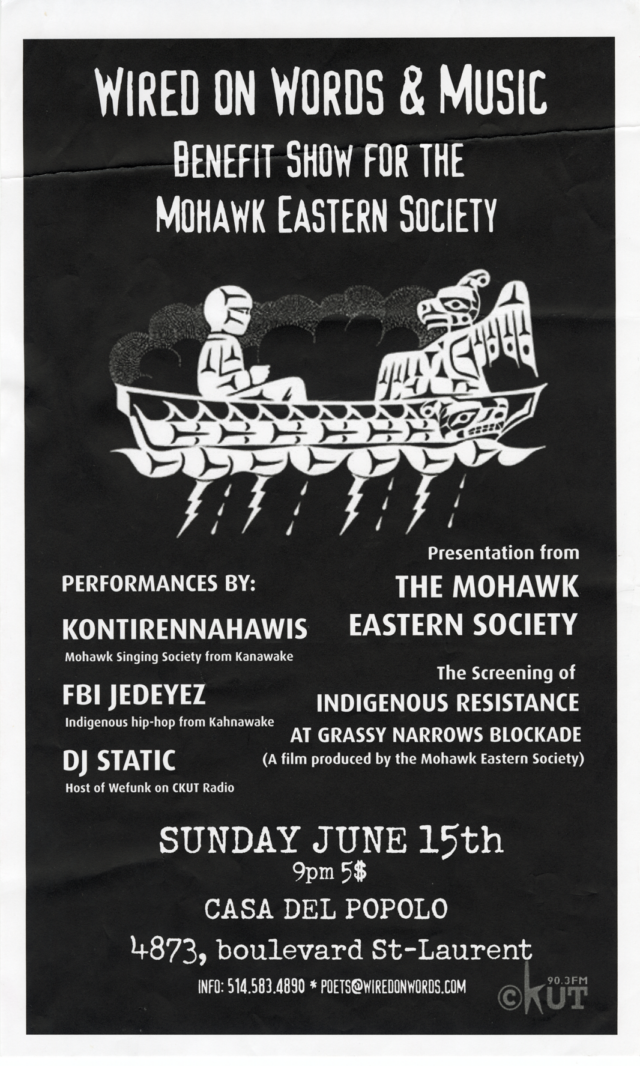Today, as street postering remains a key element in both community organizing and independent culture, I share some reflections on contributing to the street art scene in Montreal over the last two decades, as illustrated through a recent donation to the Artexte collection of posters that I have saved over the years. These posters that I have donated speak to the role of poster art in sustaining and promoting independent cultural spaces and expression, and revisit my own relationship and connection to social activism in this city.
Reflecting on my participation in street art culture in Montreal, the first images that come to my mind are late-night and early-morning-hours walks through the city, scouting out the right locations to paste up works, while carrying a bucket of wheat paste, a brush, and a knapsack full of posters announcing upcoming protests and events.
Like independent arts, grassroots political work remains deeply connected to street art culture. As independently based campaigns for vital issues in the city—such as housing rights, support for Indigenous community demands for justice, or campaigns for migrant justice—most often operate at a community level, organizationally distant from the structural institutions of power and with very small budgets, street-level communications and publicity are key. Such campaigns also often highlight critical voices that challenge the paradigms of reality asserted by mainstream politics. As their demands are often ignored or mocked by the major media, street art therefore becomes an essential tool for communicating the ideas and the conceptual and political frameworks that activists are campaigning on.
At this key moment, we can see clearly that the distance between popular opinion and government decision making is vast. Despite sustained popular demonstrations calling on the Canadian government to call for an immediate and permanent ceasefire in Gaza, the Liberal government of Justin Trudeau has nonetheless failed to take meaningful action and back even a basic appeal for ceasefire such as that which has echoed even at the highest levels of the United Nations. Instead, the Canadian government stands politically complicit in a series of unimaginable Israeli military war crimes committed against the Palestinian people of Gaza. This policy on Trudeau’s part of not calling for a permanent ceasefire remains in place, despite multiple opinion polls in Canada that clearly demonstrate broad support for a ceasefire and mass youth-led demonstrations calling for the human rights of all people, including the Palestinians, to be fully respected.
I remember a similar gap in North America in 2003, during the buildup to the unquestionably unjust US invasion of Iraq, when mass protests in the US, across western Europe, and in Canada called on the US not to intervene. Then, too, there was a great distance between the decision-making channels of state power and the common sentiment expressed by progressive community members on the street. In the case of the Iraq War, the protest movement, which included a great deal of wheatpasting and postering, was so massive and sustained that the Liberal government of the day, under Jean Chrétien, was forced to stop Canada’s military from fully participating in the invasion. Although Canada did play a supporting role to the US military, the mass demonstrations, particularly in Quebec, blocked full participation.
These examples of the distance between government policy and popular opinion are clearly expressed in the poster art found on the streets. For more than twenty years, I have been active as a grassroots street artist and a community activist in Montreal, using the tactic and format of street posters as a key element of the process of mobilization.
I have recently been working to create archival access points for poster art at various institutions, including Artexte and the Special Collections of the Concordia University Library, with the support of Concordia’s Social Justice Centre. I am now aiming to create the context for a set of posters that may be viewed and engaged with through this collection which, together with friends at Artexte, I have worked to set up.
Within this selection is, first, a poster by my friend, artist Sarah Mangle, that reads: I can imagine this place without police. I love this Risograph poster because it speaks to the essential demands of social activists calling for a defunding of police departments in the context of the broader Black Lives Matter movement, which has challenged the incredible violence that police have imposed on Black communities and many other systematically marginalized peoples, particularly Indigenous communities in Quebec and Canada. Sarah’s poster also speaks to the beauty of this movement, which calls on us to imagine a world without police and raises questions around our individual and collective dreams for a more just world.
Second, I would underline an excellent design created in support of CKUT 90.3 FM, people-powered radio in Montreal. I worked on this project with Jesse Purcell, an artist, printmaker, and member of the Justseeds Artists’ Cooperative, while I worked at CKUT as a programming coordinator. This project was undertaken to highlight CKUT and its message by using the streets as a forum of grassroots publicity for the city’s essential community radio station. Hundreds of these posters were silkscreened and pasted up. Specifically, the idea was to do street-level publicity for this radio station, which has been a sanctuary for non-commercial music and social activist movement voices.
Now I will speak to two posters about the Palestinian struggle for freedom. The first was created for an action called “Refugee camps are no one’s home,” which took place on Boulevard St-Laurent in the open lot next to the anarchist bookshop Librairie L’Insoumise. The event, which I helped organize as a member of the grassroots organization Coalition Against the Deportation of Palestinian Refugees, took place amidst the repressive political atmosphere that pervaded North America post-9/11. A group of Palestinian refugees had arrived in Canada from the US, mostly coming through New York City and then up to Montreal. Given the political climate in the US, which saw systemic attacks on the fundamental human rights of Arab and Muslim communities, many stateless Palestinians were pushed to migrate to Montreal.
A grassroots campaign was organized to support these Palestinians, who came from the Occupied Territories, including Gaza but also refugee camps in Lebanon, Syria, and Jordan. At the time, the Canadian government aimed to deport these Palestinian asylum seekers, who were mostly doing essential work as cooks and cleaners in downtown restaurants. The deportations, back to the United States, were scheduled for 2004 and 2005. This poster is one that I designed for an action that included an all-day protest camp, with tents, right on St-Laurent, as well as a live community radio broadcast aired from the protest location on CKUT 90.3 FM. Eventually, this campaign was mostly successful, as the vast majority of stateless Palestinians represented by this action group won their papers in Canada.[1]
I am also sharing a poster that was designed by Dave Ron for a campaign to support the village of Bil’in, in the Occupied Palestinian Territories. Bil’in was a central point for weekly protests against the construction by the Israeli government of a separation barrier that all major human rights groups, including Amnesty International and Human Rights Watch, have identified as a central element of the Israeli state apartheid system, which reduces Palestinians to second-class status on many levels, including full Israeli state control over Palestinian lands. A Quebec-registered company, Green Park, was involved in investment in and the creation of settlement infrastructure on the traditional Palestinian farming lands of Bil’in.[2] This silk screened poster, shared with many in the city and beyond, was one way of publicizing this campaign to support Bil’in village.
Finally, I want to share a poster for a cultural event that I helped curate at the Montreal cultural space Casa del Popolo as part of the Wired on Words and Music series, a monthly event launched by the late Ian Ferrier that I then helped coordinate, which presents poets, musicians, and other performers. I was working with a small group of Indigenous youth activists in Kahnawake who were working on reclaiming Indigenous cultural heritage through language, but were also organizing cultural events to feature the voices of Indigenous youth. I had travelled with some youths from Kahnawake to the Indigenous Algonquin blockade against corporate clearcutting in the traditional lands of Grassy Narrows First Nation, in northwestern Ontario. In the months after that trip, I kept in touch with these youths, together with whom I had driven to the blockade. This poster, which features artwork by Indigenous artist Gord Hill and advertises a benefit that featured Indigenous artists from Kahnawake, was aimed at supporting the Mohawk Eastern Society, which was deeply connected to the youth organizing efforts taking place in Kahnawake.
These posters are just a small sampling of works that I pasted up on the streets in Montreal over the years, works that speak to the intersections of art and activism present both in my own work and in that of many others in Montreal. All of these posters were created to be pasted up in the streets and formed a part of a broader political and cultural ecosystem of street art expression in this city.
Although Montreal is celebrated in tourism materials created by the city administration as a centre for independent culture and music, the practice of wheatpasting, a communications tactic that remains key to sustaining autonomous arts spaces, is still criminalized by the police. Often late-night postering runs are met with police repression—a part of the reality of street art that must be acknowledged. This reality must also be challenged, and the criminalization of street art and grassroots poster publicity must stop.
I am happy to share with Artexte this selection of posters from my archive, which can be consulted in their collection and will contribute, I hope, to wider recognition of the importance of such practices.







